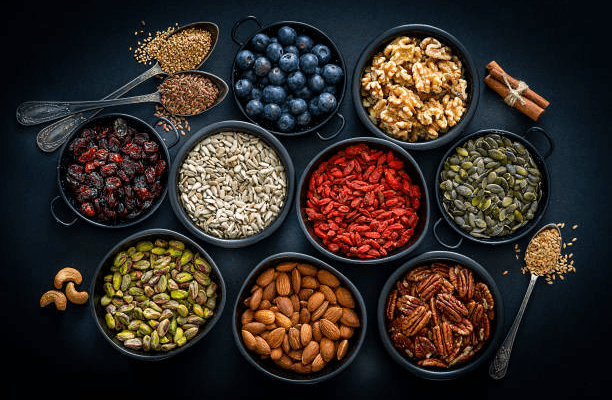India’s gastronomic scene is as varied as its culture; one of the main components adding complexity, texture, and nutrition to Indian food is the great diversity of nuts and seeds applied. From the modest peanut to the exotic pine nut, Indian cuisine uses a great range of these foods in both savory and sweet recipes. Let’s explore the realm of nuts and seeds recipes in India and find how these little powerhouses add to the rich tapestry of Indian tastes.

Indian nuts and seeds: the nutritional powerhouses
Knowing why nuts and seeds are highly prized in Indian cuisine would help us to appreciate their culinary applications. These foods are loaded with vital nutrients, not only in taste:
- Protein: Many nuts and seeds are excellent sources of plant-based protein.
- Healthy Fats: They provide heart-healthy unsaturated fats.
- Vitamins and Minerals: Nuts and seeds are rich in vitamins E, B complex, and minerals like magnesium, zinc, and selenium.
- Fiber: They contribute to digestive health and provide a feeling of fullness.
Popular Nuts in Indian Cooking
Almonds (badam)
Both whole and as almond flour or paste, almonds are extensively used in Indian cooking. Many sweets include them as a major component, and they also find application in savory cuisine.
Idea for a recipe: badam kheer, almond pudding.
- Over night, soak almonds; then, peel and ground into a paste.
- Simmer until thickened by boiling milk with sugar, then adding the almond paste.
- Arrange with chopped almonds and saffron.
Kaju (cashew)
Many Indian dishes have a creamy texture from cashews, which are also rather common in sweets.
Idea for a recipe: kaju curry
- Soak cashews then ground into a pulp.
- Sauté onions, tomatoes, and spices; then, to make a creamy curry, add the cashew paste and water.
- For a full supper, toss veggies or paneer.
Peanuts (Moongphali)
Peanut use ranges from ground into chutneys to roasted as a snack to whole in curries.
- Recipe Idea: Chutney Made with Peanut Seeds
- Ground peanuts with tamarind, red chiles, and garlic; roast them.
- For a great side dish for dosas or idlis, season with mustard seeds and curry leaves.
Seeds That Enhance Indian Cooking
Cumin Seeds (Jeera)
Cumin is one of the most common seeds used in Indian cooking, known for its distinctive aroma and flavor.
Recipe Idea: Jeera Rice
- Sauté cumin seeds in ghee until they crackle.
- Add cooked rice and salt, mix well, and garnish with coriander leaves.
Mustard Seeds (Rai)
Mustard seeds are often used as a tempering in South Indian dishes, adding a nutty, slightly spicy flavor.
Recipe Idea: Mustard Seed Tadka for Dal
- Heat oil, add mustard seeds and let them pop.
- Add this tadka to cooked dal for an instant flavor boost.
Sesame Seeds (Til)
Sesame seeds are used in both savory and sweet dishes, and sesame oil is a flavoring agent in many South Indian recipes.
Recipe Idea: Til Ladoo
- Roast sesame seeds, grind with jaggery, and shape into small balls.
- A healthy and delicious sweet treat!
Novel Uses of Nuts and Seeds in Contemporary Indian Cooking
Although classic recipes are still in demand, contemporary Indian chefs are discovering creative ways to include nuts and seeds into their works:
Nut-based Cheese: Vegan Indian cuisine is starting to feature cashew cheese really extensively.
Meats with seed-crust: grilled meats get texture from mixed seeds used as a crust.
Almond and cashew milk are dairy substitutes used in classic dishes.
Health Benefits from Indian Nuts and Seeds Recipes
Using Indian recipes to include nuts and seeds into your diet will help you greatly improve your health:
- Heart Health: Nut and seed unsaturated fats can assist to reduce harmful cholesterol.
- Though they are calorie-dense, nuts and seeds’ protein and fiber help control weight.
- Many low glycemic index nuts and seeds help to control blood sugar levels.
See our complete guide on nuts and seeds in the diet for further details on their health advantages.
Arranging and Getting Ready Nuts and Seeds

To get the most out of your nuts and seeds in Indian cooking:
Storage: Store them in airtight containers in a cool, dry place to prevent rancidity.
Soaking: Soaking nuts like almonds can make them easier to digest and increase nutrient absorption.
Roasting: Dry roasting seeds before use can enhance their flavor in recipes.
If you’re interested in learning more about traditional Indian spices and seasonings, including seeds, this guide to Indian spices is an excellent resource.
Conclusion: A Nutty Adventure with Indian Cuisine
From the creamy richness of cashews in curries to the crunchy texture of peanuts in snacks, nuts and seeds play a key part in Indian cuisine. They not only enhance the flavor and texture of foods but also supply critical nutrients, making Indian food both delicious and healthful.
Whether you’re a seasoned cook or just starting to explore Indian cuisine, including these nuts and seeds into your cooking may open up a world of flavors and textures. Experiment with different combinations and discover your favorite ways to use these versatile components.
Ready to experience some genuine Indian cuisine utilizing nuts & seeds? Why not download the HOGR app? It’s a terrific way to discover restaurants around you that provide classic and contemporary Indian cuisine. Discover the wonderful tastes of Indian nuts and seeds dishes right in your area!
Cooking with nuts and seeds is about investigating flavors, textures, and traditions, not only about following recipes. Therefore, keep in mind to be somewhat nutty with your Indian food the next time you’re in the kitchen!
Also Read- Food’s Part in Festival Food India: A Taste Trip Through Custom

















